Seagate BarraCuda Pro 14TB HDD Review: Massive Storage for Desktops
by Ganesh T S on September 10, 2018 8:01 AM ESTPerformance - Internal Storage Mode
The performance of an internal storage device is dependent on the performance characteristics of the device as well as the file system being used. In order to isolate the effects of the latter, we first benchmarked the raw drives using HD Tune Pro 5.70. It was then formatted in NTFS and subject to our standard direct-attached benchmark suite.
Raw Drive Performance
HD Tune Pro allows us to run a variety of tests to determine transfer rates and IOPS for various artificial workloads. In addition, it also allows us to visualize how the performance varies as the tracking head moves from the outer parts of the platter towards the center (i.e, transfer rates as a function of the block address).
Empty drives are bound to perform very well, but, depending on the location of the data in the drive, we find that access rates can go as low as 117 MBps for sequential workloads (compared to the 112 MBps of the 12TB drive from last year). Write access times are a bit unpredictable due to the multi-segmented cache.
Random accesses are never the strong points of hard drives, and we see that the BarraCuda Pro delivers around 69 IOPS for 4K random reads and 222 IOPS for 4K random writes. The random read performance is very similar to the performance of the 12TB version from last year, while the random write performance receives a boost up from 191 IOPS.
The extra tests help in putting some numbers to sequential accesses targeting different areas of the drive. It also provides some interesting numbers relevant to various random access workloads.
DAS Benchmarks
Consumers opting for drives such as the 12TB Seagate BarraCuda Pro typically need high-capacity local storage for holding and editing / processing large-sized multimedia files. Prior to taking a look at the real-life benchmarks, we first check what CrystalDiskMark has to report for the drive. The numbers are in the same ballpark as the 12TB version from last year.
In order to tackle the real-life use-case of transferring large amounts of data back and forth from the drive, we created three test folders with the following characteristics:
- Photos: 15.6 GB collection of 4320 photos (RAW as well as JPEGs) in 61 sub-folders
- Videos: 16.1 GB collection of 244 videos (MP4 as well as MOVs) in 6 sub-folders
- BR: 10.7 GB Blu-ray folder structure of the IDT Benchmark Blu-ray (the same that we use in our robocopy tests for NAS systems)
| Seagate BarraCuda Pro 14TB robocopy Benchmarks (MBps) | ||
| Write Bandwidth | Read Bandwidth | |
| Photos | 197.81 | 206.81 |
| Videos | 219.51 | 206.99 |
| Blu-ray Folder | 222.00 | 212.36 |
These numbers are better than the ones we obtained for the 10TB version from 2016, but, fall a little short of the performance of the 12TB drive from last year.
While processing our DAS suite, we also recorded the instantaneous transfer rates and temperature of the drive. Compared to typical disk drives, the write transfers show higher instantaneous speeds due to a combination of the firmware and the 256 MB cache inside the drive. However, sustained write rates are comparable to other high-capacity drives when the cache is exhausted. The temperature of the unit at the end of the transfers (more than 250GB of traffic) rose by less than 4C, pointing to the power-efficiency of the platform.
For the use-case involving editing of multimedia files directly off the disk, we take advantage of PCMark 8's storage benchmark. The storage workload is a good example of a user workload, involving games as well as multimedia editing applications. The command line version allows us to cherry-pick storage traces to run on a target drive. We chose the following traces.
- Adobe Photoshop (Light)
- Adobe Photoshop (Heavy)
- Adobe After Effects
- Adobe Illustrator
Usually, PCMark 8 reports time to complete the trace, but the detailed log report has the read and write bandwidth figures which we present in our performance graphs. Note that the bandwidth number reported in the results don't involve idle time compression. Results might appear low, but that is part of the workload characteristic.
| Seagate BarraCuda Pro 14TB PCMark8 Storage Benchmarks (MBps) | ||
| Write Bandwidth | Read Bandwidth | |
| Adobe Photoshop (Light) | 248.16 | 9.01 |
| Adobe Photoshop (Heavy) | 233.95 | 11.03 |
| Adobe After Effects | 89.93 | 8.73 |
| Adobe Illustrator | 202.41 | 8.47 |
Compared to the results from the 12TB drive last year, we find that the read workloads fare very similarly, but, the write workloads have a slight edge.


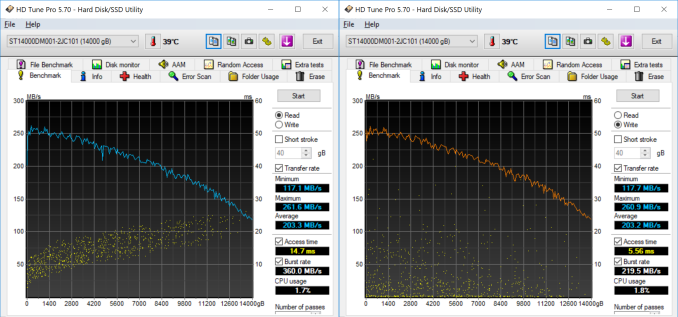
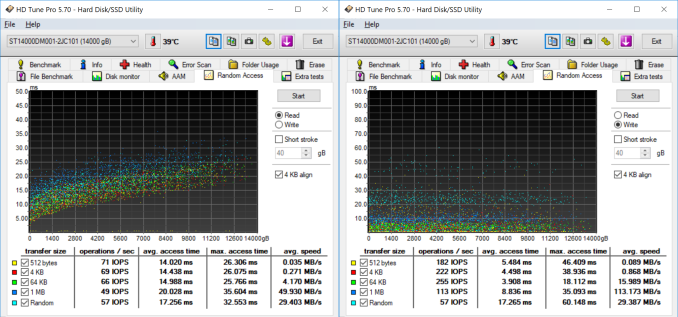
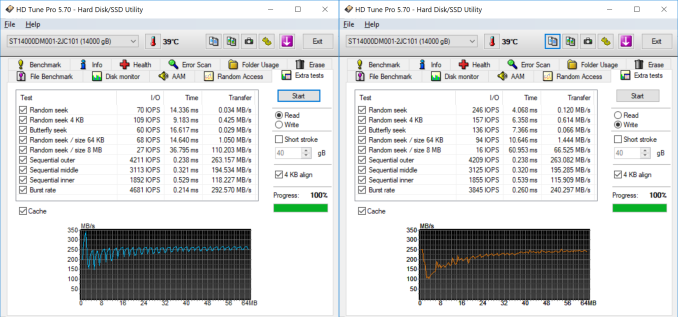
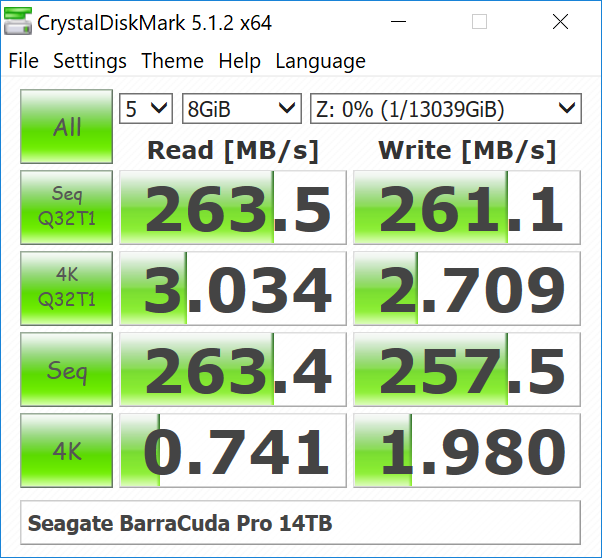
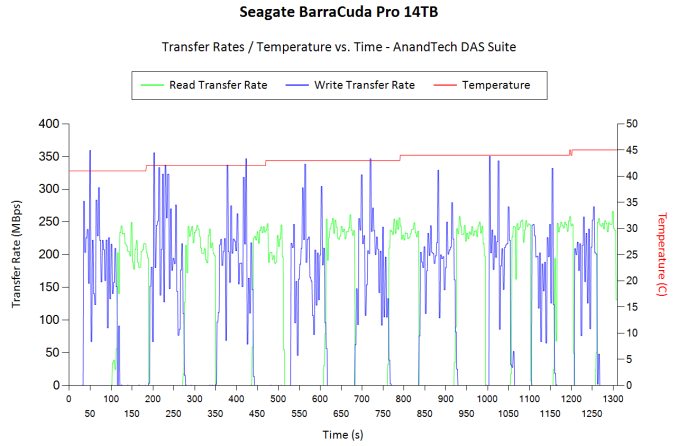








65 Comments
View All Comments
boozed - Monday, September 10, 2018 - link
*expressedXajel - Monday, September 10, 2018 - link
Using helium helps with reducing turbulence near the platters allowing them to have these platters closer to each other, or slightly thinner platter, or both of these worlds to have more platters. But another thing about He filled drives is that platters faces lesser friction than regular air-filled drives, making the motor doing less work to maintain it's speed which eventually means lower power usage.But He filled drives are more expensive to make, not because of the Helium it self which only costs a little. But because Helium is too light and can escape very easily from any tiny hole and even macroscopic holes like how Helium filled balloons inflate with time because Helium is very good at escaping, They had to design the HDD to be completely sealed to force the Helium inside. And because Helium is used mainly to put in more platters in the drive so gaining more capacity per drive there's no point in adding it to smaller drives with these extra costs and complications. The only benefit then is to save more power.
GreenReaper - Tuesday, September 11, 2018 - link
I think you mean *mi*croscopic holes. Macroscopic makes me think of Donut County:https://arstechnica.com/gaming/2018/08/donut-count...
Teknobug - Monday, September 10, 2018 - link
14GB! I haven't even filled my 1GB drives yet.Teknobug - Monday, September 10, 2018 - link
14TB & 1TB*^ brain fart
PeachNCream - Monday, September 10, 2018 - link
Same here. I've got a 1TB 2.5 inch drive in an external case that I plug into my laptop for backing up the 500GB SSD. There's less than 250GB used. Not everyone has so little data though and its nice to see Seagate seeling capacity to those that want or need it. It looks a lot like some of the features are inherited directly from enterprise drives which makes me suspect a rebrand, but not a bad one given the additional features.Samus - Monday, September 10, 2018 - link
Pfft, the ExploitedCollegeGirls library alone is 1TB...timecop1818 - Monday, September 10, 2018 - link
Seagate? Nope. Drives over 4-5TB not in RAID? Nope. I'd like to actually keep my data.Hixbot - Monday, September 10, 2018 - link
What's preventing you from using RAID with this drive? I have 5 of the 10tb versions in raid 5.wumpus - Monday, September 10, 2018 - link
Mostly cost, although once you get into 40TB raid land I suspect the convenience of >10TB drives outweighs the issue of buying multiple 8 port SATA pci-e cards to go along with 16 3TB drives. The 3TB still wins in cost (although any more and I'd look into jumping to 4TB, the cost of the ports outweighs the cost of the parity drives) and you can also bump up to RAID 6. On second thought, I'm not sure how I'm going to wrap a case around 16 drives: that might be the biggest hurdle.Not that I'm convinced that RAID6 is necessary (as far as I can tell most "you need RAID6" assumed that bad bits were randomly dispersed and that a single bad bit would kill your data, actually bad bits have to be in 4k(byte) chunks (32,000 times as rare as they thought) and that at least consumers aren't going to store anything that can't afford a single [sector] of error (at least at 40TB level). But If I'm already buying 15 hard drives for RAID5, I'll bump it up to RAID6.
Do you back that monster up on LTO? Picking up refurbished/semi-obsolete LTO for consumer gear appears complicated (but eventually justifies the cost): picking up "list price pro gear" makes more sense to have a backup RAID array.